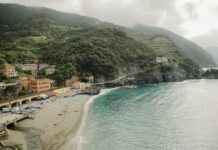A huge plume of smoke was visible Monday from the Arcachon basin. The 15,000 hectares burned in Gironde represent the equivalent of one and a half times the area of Paris.
In scorching heat, with more than 40°C, and a sky turning gray-yellow, some 8,000 people had to leave two districts of the town of La Teste-de-Buch, and 8,000 others the town of Landiras, 50 kilometers away. to the east, evacuated by the police.
At the foot of the Dune du Pilat, the five campsites from which 6,000 holidaymakers had been evacuated on Wednesday night «burnt down to 90%», said the prefect of Gironde, Fabienne Buccio. Many explosions sounded Monday afternoon, due to gas canisters left in campsites and abandoned restaurants.
«We don’t let ourselves be beaten down, the fire doesn’t do what it wants, we annoy it. We build firewalls, ditches, everything we can do around it», launched the prefect.
“The evacuation should allow the firefighters to concentrate on attacking the fire,” Lieutenant-Colonel Arnaud Mendousse, spokesman for the firefighters, told AFP.
At La Teste, Patricia Monteil is «in panic», says this forty-year-old, piling as many things as possible in her car, especially clothes. «I’m going to my daughter’s (in another neighborhood) but if it burns there too, I don’t know what to do.»
– Hot night –
Many local heat records were broken on this «hottest day of this heat wave», announced Météo-France, the second heat wave since June.
According to provisional values recorded at 5 p.m., the thermometer for example showed 39.3°C in Brest (against a previous record of 35.1°C in August 2003), 39.5°C in Saint-Brieuc (against 38, 1°C in August 2003), 42°C in Nantes (compared to 40.3°C in July 1949) or 42.6°C in Biscarrosse (compared to 41.7°C in June 2022).
The night from Monday to Tuesday will not give any respite: the temperature will not fall below 25°C from the Loire to Normandy and the east of Brittany.
No one is sheltered any longer: the peak of this 45th heat wave recorded in France since 1947 affects the western facade, from Landes and Gers to Finistère.
The proliferation of extreme weather events is a direct consequence of global warming according to scientists, with greenhouse gas emissions increasing in intensity, duration and frequency.
– «Panic» –
In the South-West, strong gusts of wind will follow the heat wave, alerted Météo-France on Twitter: «mercury drop from 15 to 20° and gusts of westerly wind at 60 to 70 km / h. Phenomenon suddenly spreading from the Basque coast to the Arcachon basin between 6 and 9 p.m.
Paris has launched its heat wave plan: parks open until midnight, refreshed rooms open to the public, vulnerable people contacted by telephone.
The agricultural world is also suffering. In the middle of the harvest, crop fires, caused by the friction of the blades of combine harvesters, broke out as far as northern France.
The Loire department is testing the spreading of milk of lime on the roadway instead of gravel to limit the rise in temperature and prevent the molten bitumen from sticking to car tires.
– Risk of thunderstorm –
The red alert was maintained Monday at 4 p.m. for the following departments: Charente, Charente-Maritime, Côtes-d’Armor, Dordogne, Finistère, Gers, Gironde, Ille-et-Vilaine, Landes, Loire-Atlantique, Lot-et -Garonne, Maine-et-Loire, Morbihan, Deux-Sèvres and Vendée.
Météo-France has extended orange vigilance to new departments, bringing the total to 69.
The temperatures will drop and «heat wave red vigilance» should be lifted on the vigilance map for Tuesday morning at 6 a.m.», still indicates Météo-France, while the high temperatures will shift «over the eastern half of France» with temperatures between 37 and 40°C.
Météo-France also warns of the risk of thunderstorms in the southern Alps.
This heat wave affects all of Western Europe, also causing forest fires in Spain or Portugal. About half of the territory of the European Union is currently facing a risk of drought, the European Commission announced on Monday.















